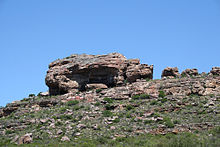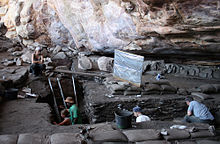- Diepkloof Rock Shelter
-
Diepkloof Rock Shelter is a rock cave in Western Cape, South Africa in which has been found some of the earliest evidence of the human use of symbols, in the form of patterns engraved upon ostrich eggshell water containers. These date around 60,000 years ago.[1][2]
The symbolic patterns consist of lines crossed at right angles or oblique angles by hatching. It has been suggested that "by the repetition of this motif, early humans were trying to communicate something. Perhaps they were trying to express the identity of the individual or the group."[3]
Contents
Site description
The cave is about 17 km from the shoreline of the Atlantic in a semi-arid area, near Elands Bay about 150 km north of Cape Town.[2] It occurs in quartzitic sandstone in a butte that overlooks in a east direction 100 m above the Verlorenvlei River. It contains one of "most complete and continuous later Middle Stone Age sequences in southern Africa"[1] stretching from before 130,000 BP to about 45,000 BP and encompassing pre-Stillbay, Stillbay, Howiesons Poort, and post-Howiesons Poort periods. It is about 25 m wide and 15 m deep. Research is based upon finds discovered in a trench excavated within it that is 16 m across and 3.6 m in depth. The deposits consist of burnt and nonburnt organic residues and ash that came from hearths, ash dumps and burnt bedding.[1]
It was first excavated in 1973 by John Parkington and Cedric Poggenpoel.[4] Since 1999 it has been researched in a collaboration between the Department of Archaeology at the University of Cape Town and the Institute of Prehistory and Quaternary Geology at the University of Bordeaux.[2]
Engraved ostrich eggshell containers
270 fragments of ostrich eggshell containers have been found covered with engraved geometric patterns. The fragments have a maximum size of 20–30 mm, though a number have been fitted into larger 80 × 40 mm fragments. It is estimated that fragments from 25 containers have been found. Eggshell fragments have been found throughout the period of occupation of the cave but those with engraving are found only in several layers within the Howiesons Poort period. These occur across 18 stratigraphic units, particularly those with the stratigraphic names Frank and Darryl. This suggests the tradition of engraving lasted for several thousand years.[1]
The engraving consists of abstract linear repetitive patterns, including a hatched band motif. One fragment has two parallel lines that might have been circular around the container.
It has been suggested that they form "a system of symbolic representation in which collective identities and individual expressions are clearly communicated, suggesting social, cultural, and cognitive underpinnings that overlap with those of modern people."[1] Moreover, they show "the development of a graphic tradition and the complex use of symbols to mediate social interactions. The large number of marked pieces shows that there were rules for composing designs but room within the rules to allow for individual and/or group preferences."[1]
Earlier finds exist of symbolism, such as the 75,000-year-old engraved ochre chunks found in the Blombos cave, but these are isolated and difficult to tell apart from meaningless doodles.[3]
The engravings are found on ostrich eggshells that were used as water containers. Ostrich eggshells have an average volume of 1 liter. They may have had drinking spouts, holes to enable them to be strung as a canteen for easier carrying, and seem to have been part of "daily hunter-gatherer life".[1] They involved skill to make, with one of the researchers involved noting "Ostrich egg shells are quite hard. Doing such engravings is not so easy."[3]
Local flora
The preservation of organic matter such as wood, grass, seeds and fruits at the site has been described as "exceptional".[2] Pollen remains allow the identification of the local animals and plants. The Howiesons Poort period shows evidence for thicket or shrubland vegetation now usually found in gorges, such as Diospyros, Cassine peragua, Maytenus, Rhus, and Hartogiella schinoides. Afromontane trees found in the area, include Ficus, Kiggelaria africana, Podocarpus elongatus, and Celtis africana. This suggests a more diversely wooded riverine environment than now present in the area.[1]
Animal remains
Animal remains include those of mammals, tortoises and intertidal marine shells. Most bones found in the cave come from rock hyrax, hares, cape dune mole rats, steenbok and grysbok. Animals from rocky environments are also found including klipspringer, and vaalribbok. There is also evidence of local grasslands. with remains of zebras, wildebeest and hartebeest. Hippopotamus and southern reedbuck came from the local river. The sea coast seems to have moved up the river, as there are fragments from black mussels, granite limpets, and Cape fur seals. Though there are ostrich-shell remains, no ostrich bones have been found.[1]
Tortoise bones are mostly those of the angulate tortoise that is still found in the area. These are noted to have been "remarkably large compared with their Late Stone Age counterparts, suggesting different intensities of predation between MSA and Late Stone Age populations".[1]
References
- ^ a b c d e f g h i j Texier PJ, Porraz G, Parkington J, Rigaud JP, Poggenpoel C, Miller C, Tribolo C, Cartwright C, Coudenneau A, Klein R, Steele T, Verna C. (2010). "A Howiesons Poort tradition of engraving ostrich eggshell containers dated to 60,000 years ago at Diepkloof Rock Shelter, South Africa". Proceedings of the National Acadademy of Science U S A. 107: 6180–6185. doi:10.1073/pnas.0913047107 PMID 20194764
- ^ a b c d Tribolo, C. Mercier, N., Valladas, H. Joron J.L., Guibert P., Lefrais Y., Selo M., Texier P.-J., Rigaud J.-Ph., Porraz G., Poggenpoel C., Parkington J., Texier J.-P., Lenoble A.. (2009) "Thermoluminescence dating of a Stillbay–Howiesons Poort sequence at Diepkloof Rock Shelter (Western Cape, South Africa)". Journal of Archaeological Science, 36: 730–739. doi:10.1016/j.jas.2008.10.018
- ^ a b c Amos, J. (2010). Etched ostrich eggs illustrate human sophistication. BBC News
- ^ Parkington, J., Poggenpoel, C. (1987). "Diepkloof Rock Shelter". In: Parkington, J., Hall, M. (Eds.), Papers in Prehistory of the Western Cape, South Africa, vol. 332. BAR International, pp. 269–293. ISBN 9780860544258
External links
Coordinates: 32°23′12″S 18°27′10″E / 32.38667°S 18.45278°E
Categories:- Archaeological sites in South Africa
- Caves of South Africa
- Paleolithic
- Middle Stone Age
- Human behavior
- Paleoanthropological sites
Wikimedia Foundation. 2010.



